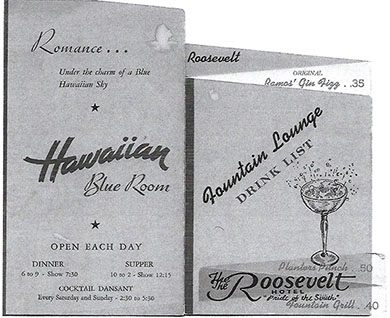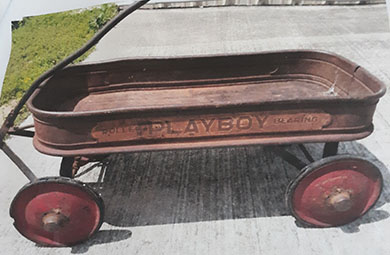 |
|
|||
 |
 |
|||
RINKER ON COLLECTIBLES — Column #1811 Copyright © Harry Rinker, LLC 2021 Questions
and Answers
QUESTION: I have a drink and sandwich menu from the Fountain Lounge of The Roosevelt Hotel, “The Pride of the South.” The menu dates from the late 1930s. The hotel was located in New Orleans. Does it have any value? – SD, Lansdale, PA, Email Questiom 
ANSWER: The Roosevelt Hotel in New Orleans, now owned by AVR Realty Company and Dimension Development and managed by Waldorf Astoria Hotels & Resorts, has a long and distinguished history. Louis Grunewald, a German immigrant, built The Hotel Grunewald, the initial six-story hotel, and opened it in 1893. The hotel with its 200 rooms was located on Baronne Street. In 1900, Grunewald developed plans for an Annex, designed by Toledano & Wogan, on the University Place side of the block. The new tower was 14 stories tall and had 4000 rooms. The Annex, which included The Fountain Lounge, opened on January 1, 1908. In 1923, Louis’s son Theodore Grunewald sold the hotel to a group of businessmen. They tore down the original building and redecorated and upgraded the annex. The hotel was named The Roosevelt in honor of President Theodore Roosevelt on October 31, 1923. The new Baronne Street tower was opened on October 1, 1925. Its Romanesque Room (now the Venetian Room) became a premier jazz venue. The hotel changed hands several times. In the 1930s, its Blue Room was a major music venue featuring big bands such as Tommy Dorsey and Glen Miller. The Fountain Lounge was renovated and reopened on September 1, 1938. U.S. Senator Huey P. Long was a frequent guest at the hotel and The Fountain Lounge visitor. He drank Ramos gin fizzes. The current owners of the hotel purchased it in August 2007. They invested $100 million in renovations to raise the level of the facilities to became part of the Waldorf Astoria Collection chain. Worthpoint.com’s Worthopedia has over 150 listings, many of which are menus, for The Hotel Roosevelt. Collector interest in the Roosevelt memorabilia is strong. Your Fountain Lounge menu has a secondary market value between $10.00 and $15.00. QUESTION: I received a farm table from my grandparents. Grandma rolled her pie crusts on it. There is a label inside the drawer that reads: “MUTSCHLER / Porce Namel / KITCHEN FURNITURE.” It has a white porcelain top, wood skirt with a drawer, and U-shaped tubular legs. It measures 40 x 25 x 31 inches. It is accompanied by two chairs with tubular backing and legs. My grandfather repainted the chairs and the skirt. The top has one “owie” on one side. I am guessing it is from the 1940s. I tried to sell it for $300.00 but had no offers. What can you tell me about the table and what would be a reasonable selling price? -- DB, Washington, OH, Email Questiom 
ANSWER: A good backstory often turns the ordinary into something special. This is the case with your kitchen table. What may appear ordinary, actually is a kitchen table with strong Modernist design era elements. Mutschler Bros Co. began as Coppes, Zook & Mutschler located in Nappanee, Indiana, in 1876. The company made wooden bedroom and dining furniture and tables for use at home and the office. Coppes, Zook & Mutschler split in 1914 into Coppes Bros. and Zook (Coppes Bros. eventually bought out Zook) and Mutschler Brothers. Both companies became competitors in the manufacturing of kitchen cabinetry. Mutschler Bros. gained a reputation for incorporating porcelain-enamel work surfaces in its kitchen cabinets. It introduced a line of “Porce-Namel” tables with the “LAFLAT” tops. In the 1930s, Mutschler Bros. developed a line of Porta-Bilt cabinets that could be installed and easily removed and taken with the owner when he/she/they moved. Following World War II, steel was adapted to kitchen cabinetry and accessories. In 1955, R. C. “Dick” Chapman, a Mutschler son-in-law, and Richard “Dick” Behm of the Hardwood Plywood Manufacturers Association met in Chicago to discuss the future of wood kitchen cabinets and tables. In the 1960s, Mutschler hired Paul McCobb, a trend-setting furniture designer, to create “Eurostyle” designs for its kitchen cabinetry. The designs included aluminum extruded legs. American Standard acquired Mutschler in 1969. American Standard was bought by Triangle Pacific in 1974. The Mutschler Nappanee plant discontinued cabinet production in 1987. Your table is an example of post-World War II Modernism. 1950s and 1960s Modernist furniture, especially with a designer attribution, is a hot commodity. Your grandfather’s painting of the table skirt and chairs had a negative impact on value. The table and chairs are no longer in period condition. If the set had not been repainted and was in useable condition, the asking price of $300.00 was reasonable. A Modernist collector will not be content until the table and chairs are restored to their period condition, a cost that would range between $100.00 to $150.00. Given this, a more reasonable asking price for the table and chairs is around $150.00. If you are willing to do the restoration yourself, then the $300.00 asking price is valid. When advertising the table and chairs, restored or not restored, add the backstory. The more a collector knows, the more he/she is willing to pay. st QUESTION: I have a child’s “PLAYBOY” coaster wagon that I picked up at curbside in 2006 in Cleveland, Ohio. I tried researching it on the internet. All I found was a December 13, 1933, newspaper advertisement in “The Herald Statesman” published in Yonkers, New York. I am hoping you can provide me with some additional information. – DR, Thibodaux, LA, Email Question 
ANSWER: I found a “Playboy” steel wagon for sale on eBay. The seller attributed it to Hibbard, in reality Hibbard, Spencer, Bartlett & Co. of Chicago. Although primarily a manufacturer of cutlery and tools, the company also sold toys and other children’s items, such as wagons. The example I found had different wheels and appears to be a later model. The steel bodies and name are identical. Hibbard, Spencer, Bartlett & Co. was a wholesale manufacturer. Its products appeared in wholesale and mail order catalogs. It often rebranded products for specific mail order companies. I found an advertisement for a “Flyaway” wagon that is identical to the wagon you own except for the name. Liberty Coaster, another Chicago wagon manufacturer, started making stamped steel body coasters in 1927. Liberty Coaster became Radio Steel & Manufacturing in 1930. Their wagons were named Radio Flyers. Hibbard’s steel body wagon was a knock-off, an attempt to capitalize on the demand for steel body wagons. Changing the design slightly and adding a different type of wheel featuring roller bearings was enough to avoid a charge of copyright infringement. Your wagon is in poor to fair condition. Even so and like you, I would not have passed up the opportunity to acquire it for free via a little dumpster diving. Rather than restore it, I recommend leaving it as you found it. It you do want to restore it, have it done by a recognized professional. Amateur restoration reduces value. One final note: The seller asking price for the later Hibbard Playboy wagon listed on eBay is an “only in your wildest imagination” price. READERS RESPONSE: Several months ago, I responded to a query from DDeV in Eugene, Oregon, asking for advice as to what to do with a collection of glass fragments from the stained glass windows in the Reims Cathedral. During World War II, her father was inside the Reims Cathedral when a bomb struck and shattered the windows causing glass shards to fall on him. I recommended she contact the Cathedral to see if they had any interest in having them; and, if yes, donating them. On September 8, 2021, I received the following email from DDeV: “I contacted the Reims Cathedral and the dean of the Cathedral answered and said yes, we would like to have those stained glass shards. They have an archive of things like that. I mailed them last month, and they are now back where they came from. It made me so happy to have finally found their rightful home.”
|
||||